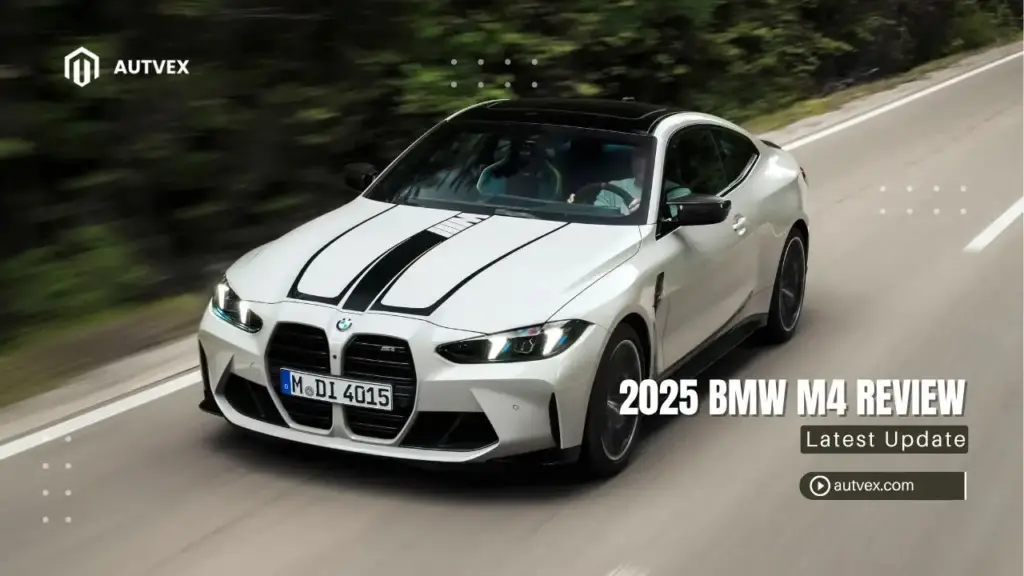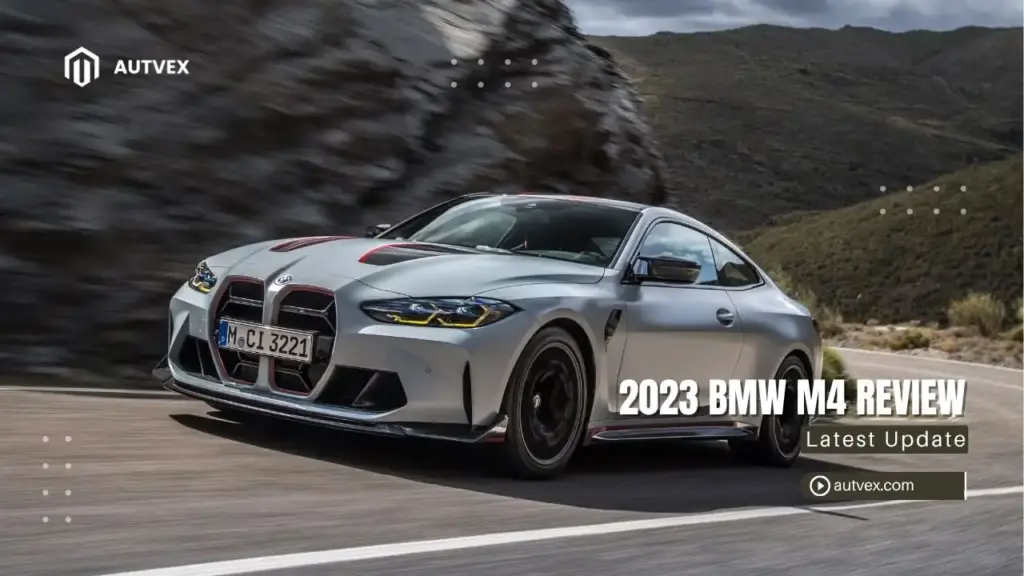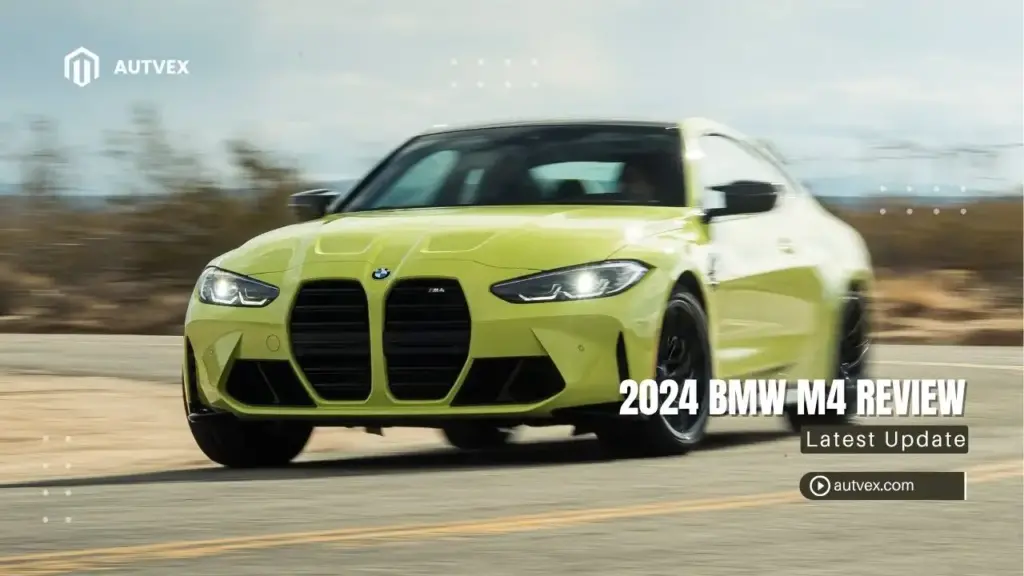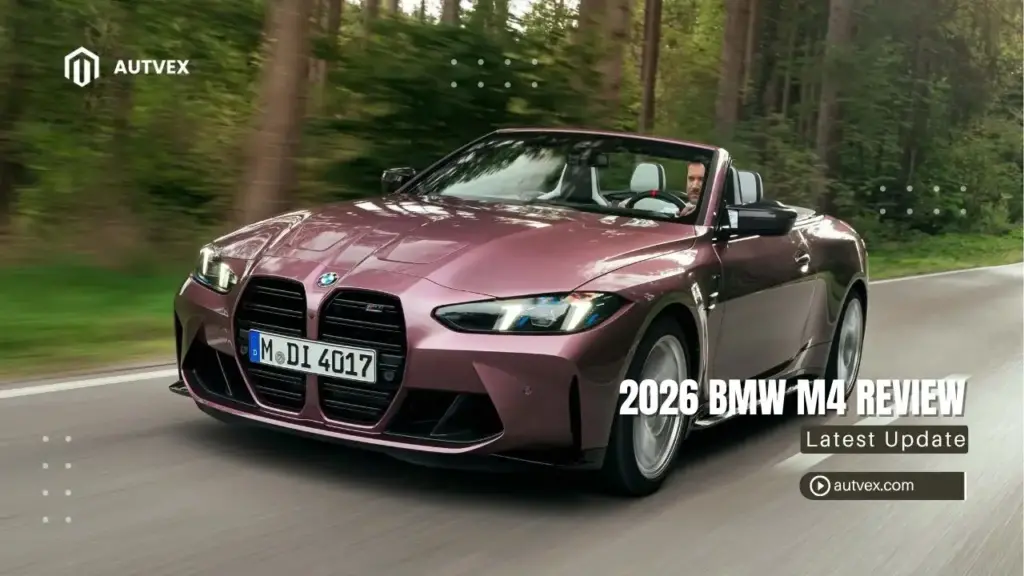You may also like:
The 2025 BMW M4 is a high-performance luxury coupe starting at $80,875, delivering between 473 to 543 horsepower from its twin-turbocharged 3.0-liter inline-six engine. For 2025, Competition xDrive models gain 20 additional horsepower, reaching 523 hp, while updates include redesigned LED headlights, laser taillights borrowed from the M4 CSL, and upgraded iDrive 8.5 software. With 0-60 mph times as low as 2.7 seconds in the limited-edition M4 CS and a manual transmission still available on base models, the M4 combines brutal acceleration with luxury appointments, though reviewers note numb steering feel and a sometimes harsh ride[1][2].
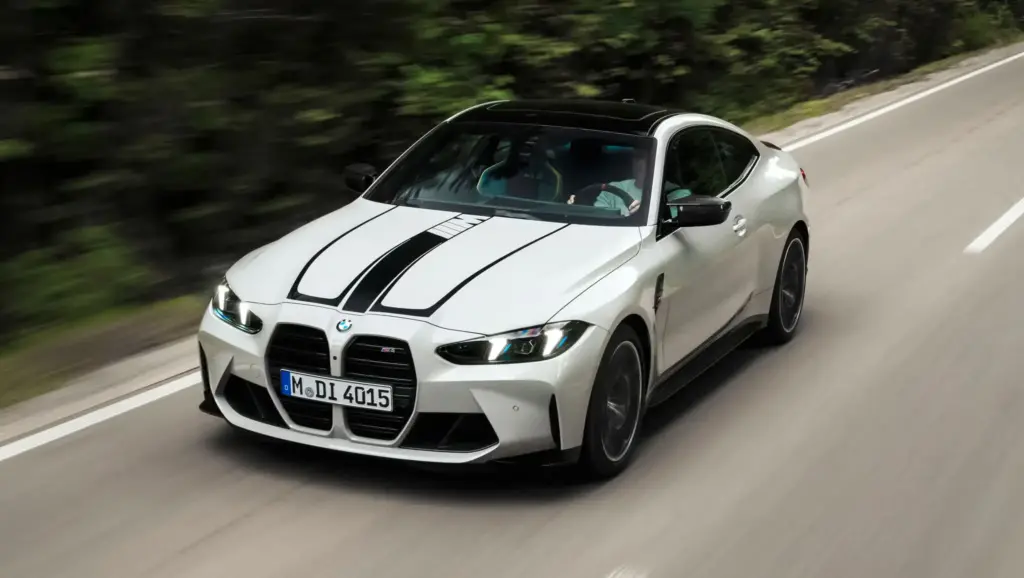
2025 BMW M4 Overview
What’s New for 2025
BMW delivers meaningful upgrades to the M4 lineup for 2025, headlined by a 20-horsepower increase for Competition xDrive models[1]. This bump pushes output from 503 hp to 523 hp, providing additional thrust for all-wheel-drive variants without compromising efficiency.
Key 2025 updates include:
- Revised LED headlights featuring narrower profile with updated daytime running light signature
- Striking new LED taillights with laser technology borrowed from the track-focused M4 CSL
- Updated iDrive 8.5 software featuring refined interface and enhanced M-specific performance graphics
- Redesigned flat-bottom steering wheel with improved ergonomics
- New exterior badge styling and updated BMW roundel design
- Expanded customization options including exclusive colors, new interior trims, and lightweight forged wheel designs
These refinements keep the M4 competitive against rivals like the Mercedes-AMG C63 and Audi RS5 while maintaining BMW’s performance heritage. According to Autvex automotive experts, the power increase specifically targets buyers who demand maximum acceleration without sacrificing all-weather capability.
Who Should Consider the 2025 M4
The M4 appeals to a specific buyer profile seeking the intersection of track capability and daily drivability. Performance enthusiasts who regularly attend track days but need a practical daily driver find the M4’s versatility compelling.
Ideal buyers include:
- Track-day enthusiasts wanting a capable car that doesn’t require a trailer
- BMW M Division loyalists seeking the latest iteration with current technology
- Buyers prioritizing straight-line speed and advanced electronics over analog driving feel
- Manual transmission purists wanting one of the last six-speed performance coupes available
- Previous M3/M4 owners upgrading to the latest generation
The M4 particularly suits buyers who appreciate modern performance technology like adaptive dampers, all-wheel steering, and configurable drive modes. However, those seeking pure, unfiltered driving engagement may find the M4’s electronic systems somewhat insulate driver feedback.
Key Strengths and Weaknesses
Advantages:
| Strength | Details |
|---|---|
| Brutal twin-turbo power | 473-543 hp depending on trim, with relentless acceleration[1] |
| Aggressive styling | Polarizing but attention-grabbing design with functional aerodynamics |
| Advanced technology | iDrive 8.5, wireless connectivity, M-specific performance displays |
| AWD traction | xDrive system provides all-weather capability with rear-biased character |
Disadvantages:
- Sometimes harsh ride: Firm suspension transmits road imperfections, especially with larger optional wheels[1]
- Numb steering feel: Precise but lacking tactile feedback compared to rivals and previous generations[3]
- Complex drive modes: Overly complicated configurable settings require learning curve
- Polarizing grille: Oversized vertical kidney grille described as “a mug only a mother could love”
Compared to previous M4 generations, the G82 chassis prioritizes capability over pure engagement. While faster and more composed, some enthusiasts miss the rawness of F80 and E92 predecessors.
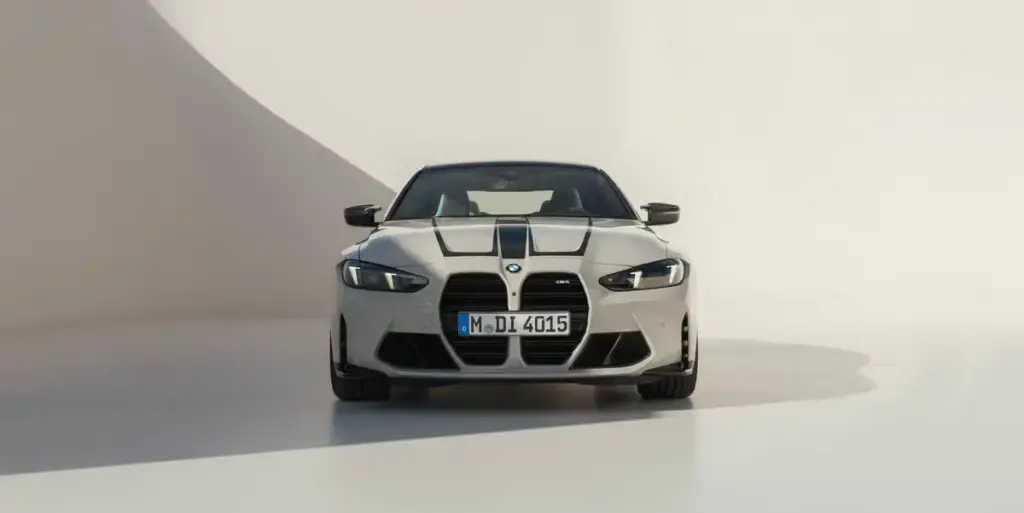
Trim Levels and Pricing
M4 Base Coupe (Manual)
| Specification | Details |
|---|---|
| Starting MSRP | $80,095 (including $995 destination)[4] |
| Engine | 473 hp @ 6,250 rpm, 406 lb-ft torque |
| Transmission | 6-speed manual |
| Drivetrain | Rear-wheel drive |
| 0-60 mph | 4.1 seconds[1] |
The base M4 serves driving purists seeking maximum engagement through a traditional three-pedal configuration. Standard equipment includes adaptive M suspension, 18-inch front/19-inch rear staggered wheels, carbon-fiber roof, Merino leather upholstery, and BMW Curved Display with iDrive 8.5.
Reviewers note the manual’s shift action feels somewhat “rubbery” compared to previous generations, though it remains one of the last available stick-shift performance coupes in this segment[1].
M4 Competition Coupe (RWD)
Starting at approximately $86,000, the Competition trim delivers 503 horsepower through an eight-speed automatic transmission[4]. The $6,000 premium over base models nets 30 additional horsepower, quicker shifts, and Competition-specific calibrations for suspension and steering.
Competition upgrades include:
- Enhanced engine management delivering 503 hp and 479 lb-ft torque
- Eight-speed M Steptronic automatic with launch control
- Competition-specific adaptive suspension tuning
- High-gloss Shadowline exterior trim
- 19-inch front/20-inch rear forged M wheels
The Competition strikes a balance between the base model’s engagement and the xDrive’s maximum performance, making it ideal for rear-drive purists who want additional power without all-wheel-drive complexity.
M4 Competition xDrive (Coupe and Convertible)
For 2025, Competition xDrive models receive a 20-horsepower bump to 523 hp, making them the quickest M4 variants outside the limited CS model[1].
| Body Style | Starting MSRP | 0-60 mph |
|---|---|---|
| Competition xDrive Coupe | $90,175[4] | 3.4-3.5 seconds[1] |
| Competition xDrive Convertible | $97,175 | 3.5-3.6 seconds |
The xDrive all-wheel-drive system operates with rear bias, maintaining M car character while improving traction during launches and in adverse conditions. For buyers in snow-belt regions or those seeking maximum acceleration, xDrive justifies its premium through measurable performance gains and year-round usability.
The convertible body style exclusively comes with Competition xDrive specification, featuring a power-operated soft top that retracts in approximately 18 seconds at speeds up to 31 mph.
M4 CS (Limited Edition)
The ultimate M4 variant, the M4 CS starts at $124,675 and represents the pinnacle of BMW M performance before the ultra-exclusive CSL[5]. Limited to approximately 1,700 units, the CS delivers:
Performance specifications:
- 543 horsepower and 479 lb-ft torque (20 hp over standard Competition xDrive)
- 0-60 mph in 2.7-2.8 seconds with quarter-mile times of 10.7 seconds[5][6]
- 70-pound weight reduction through carbon-fiber components
- Standard xDrive all-wheel drive with reprogrammed transmission
- Titanium exhaust system delivering more aggressive sound
Enthusiasts praise the M4 CS as potentially “the best M car I’ve ever driven,” with track performance matching or exceeding cars costing significantly more[5]. However, the nearly $45,000 premium over base M4 positions it as a collector’s item rather than practical daily driver choice.
Standard and Optional Equipment
Base features across all trims:
- Adaptive M suspension with electronically controlled dampers
- Carbon-fiber roof (coupe models)
- M Sport seats with enhanced bolstering
- BMW Live Cockpit Professional with 12.3-inch digital cluster and 14.9-inch touchscreen
- iDrive 8.5 operating system
- 16-speaker Harman Kardon surround sound
- Wireless Apple CarPlay and Android Auto
- BMW Active Driving Assistant safety suite
Available packages and options:
- Driving Assistance Professional Package ($1,700): Adaptive cruise control, extended traffic jam assistant, steering/lane control
- Executive Package ($3,550): Ventilated front seats, gesture controls, wireless charging
- M carbon-ceramic brakes ($8,500): Fade-resistant braking for track use
- M carbon bucket seats ($4,000): Significant weight savings with track-focused bolstering
- BMW Individual colors: Frozen paint finishes and exclusive colors ($2,500-$5,000)
For buyers navigating the car buying process timeline, BMW dealers typically require 8-12 weeks for factory orders with Individual options.
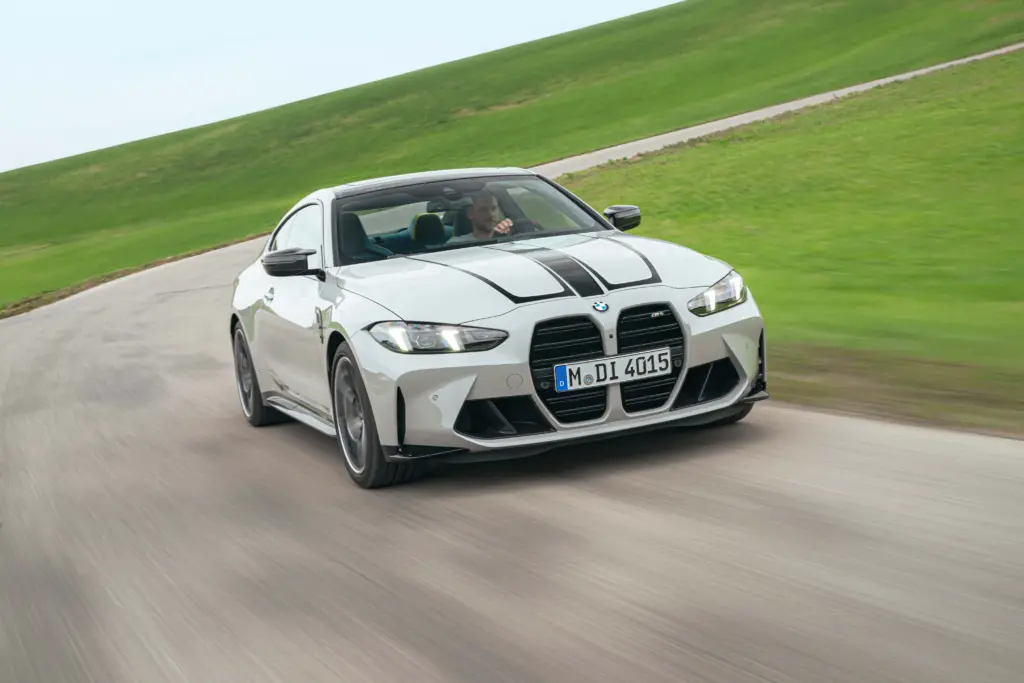
Engine and Performance
S58 Twin-Turbocharged Inline-Six Engine
BMW’s S58 3.0-liter inline-six represents the evolution of decades of M Division engineering. This twin-turbocharged powerplant delivers explosive performance across all M4 variants while maintaining impressive refinement[1].
Engine specifications by trim:
| Trim Level | Horsepower | Torque | Redline |
|---|---|---|---|
| Base | 473 hp @ 6,250 rpm | 406 lb-ft @ 2,650 rpm | 7,200 rpm |
| Competition RWD | 503 hp | 479 lb-ft @ 2,750 rpm | 7,200 rpm |
| Competition xDrive (2025) | 523 hp @ 6,250 rpm | 479 lb-ft @ 2,750 rpm | 7,200 rpm |
| M4 CS | 543 hp @ 6,250 rpm | 479 lb-ft @ 2,750 rpm | 7,200 rpm |
The S58 features aluminum construction, forged internals, and sophisticated cooling systems managing both engine block and cylinder head temperatures independently. Engineers describe the engine as “smooth, forceful, and willing to rev past 7,000 rpm,” delivering linear power delivery without abrupt turbo lag[2].
Acceleration and Speed Performance
The M4 delivers staggering acceleration regardless of configuration, with performance scaling predictably with power and drivetrain choices.
Tested acceleration figures:
- Base manual: 0-60 mph in 4.1 seconds, quarter-mile in 12.4 seconds @ 117 mph[1]
- Competition RWD: 0-60 mph in 3.8 seconds (estimated), quarter-mile in 12.0 seconds
- Competition xDrive: 0-60 mph in 3.4-3.5 seconds, quarter-mile in 11.6 seconds[1]
- M4 CS: 0-60 mph in 2.7 seconds, quarter-mile in 10.7 seconds @ 127 mph[5]
Top speed specifications:
- Standard models: 155 mph electronically limited
- With M Driver’s Package: 180 mph
- M4 CS: 188 mph maximum
Real-world testing confirms manufacturer claims, with the Competition xDrive consistently achieving sub-3.5-second 0-60 runs in optimal conditions. The M4 CS’s 2.7-second sprint matches or exceeds supercars costing double its price.
Transmission Options
BMW offers two distinct transmission choices catering to different driving philosophies.
Six-speed manual transmission:
- Standard on base M4 Coupe only
- Traditional three-pedal engagement for driving purists
- Approximately 50 pounds lighter than automatic
- Shift action described as somewhat “rubbery” by reviewers[1]
- Last-generation manual option in luxury performance segment
Eight-speed M Steptronic automatic:
- Standard on Competition and CS models
- Lightning-quick shifts (sub-100 milliseconds in Manual mode)
- Launch control delivers consistent acceleration
- Adaptive shift patterns learn driver behavior
- Automated rev-matching during downshifts
The manual-versus-automatic debate centers on engagement versus outright speed. Manual advocates appreciate the involvement at 7/10ths driving, while the automatic delivers superior track times and daily convenience.
Drivetrain: RWD vs xDrive AWD
Buyers face a fundamental choice between traditional rear-wheel drive and modern all-wheel drive.
Rear-wheel drive advantages:
- Traditional sports car dynamics with playful oversteer
- Electronic limited-slip differential manages traction
- Lighter weight (approximately 100 pounds less than xDrive)
- Purist preference for rear-drive M car character
- Lower purchase price
xDrive all-wheel drive advantages:
- Improved traction in all conditions, especially wet/snowy weather
- Faster acceleration from standstill and low-speed corners
- Rear-biased torque distribution maintains M dynamics
- 20 additional horsepower on 2025 models (523 hp vs 503 hp)[1]
- Launch control produces repeatable performance
The xDrive system operates intelligently, sending power forward only when rear traction is exceeded. This maintains the M4’s characteristic handling balance while providing measurable performance and safety benefits.
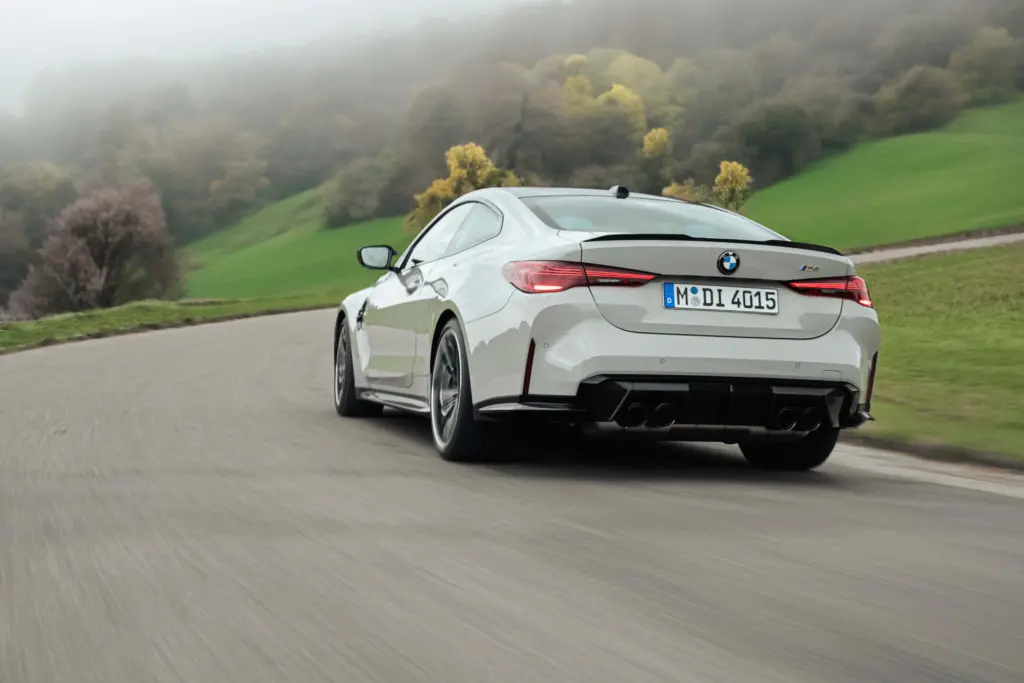
Handling and Driving Dynamics
Chassis and Suspension Setup
The M4’s chassis incorporates BMW’s latest performance technologies creating exceptional capability on track while remaining tolerable for daily driving.
Key chassis features:
- Adaptive M suspension: Electronically controlled dampers adjust compression/rebound 500 times per second
- All-wheel steering: Rear wheels turn up to 2.5 degrees improving agility and high-speed stability (standard on 2025 models)
- Electronic limited-slip differential: Actively distributes torque between rear wheels
- Weight distribution: Nearly ideal 51/49 front-to-rear balance
- Structural rigidity: Carbon-fiber roof brace and reinforced chassis mounting points
Three primary suspension modes—Comfort, Sport, and Track—provide distinct tuning philosophies. Comfort mode softens damping for highway cruising, Sport balances response and compliance for back roads, while Track mode maximizes stiffness prioritizing lap times over comfort.
Steering Feel and Driver Feedback
The M4’s steering represents its most consistent criticism among reviewers and enthusiasts[1][3].
Steering characteristics:
- Precision: Excellent on-center accuracy with quick 2.3-turn lock-to-lock ratio
- Weighting: Progressive effort building naturally with cornering forces
- Feedback: Noticeably numb compared to hydraulic systems in previous M4 generations and current rivals
- Track suitability: Confidence-inspiring accuracy despite limited tactile communication
Multiple reviewers describe steering feedback as “MIA” (missing in action), noting the disconnect between steering inputs and road surface communication[1]. While the M4 places the car exactly where intended, the electronic power steering system filters out texture and subtle cues enthusiasts crave.
Braking Performance
Standard M compound brakes provide impressive stopping power suitable for aggressive street driving and occasional track use.
Brake specifications:
- Front: 15.6-inch rotors with six-piston calipers
- Rear: 15.0-inch rotors with single-piston calipers
- 60-0 mph: 105-107 feet (depending on tire compound)
- Fade resistance: Moderate during repeated track sessions
Optional M carbon-ceramic brakes ($8,500):
- 41-pound weight reduction (unsprung mass)
- Superior fade resistance during extended track sessions
- Increased maintenance costs and cold-weather performance compromises
- Recommended primarily for dedicated track enthusiasts
For typical driving patterns including spirited canyon runs and occasional track days, standard brakes prove more than adequate. The carbon-ceramic upgrade makes sense only for buyers logging significant track time or seeking every possible weight advantage.
Drive Modes and Customization
The M4 offers extensive configurability through its drive mode system, though complexity sometimes frustrates owners.
Configurable parameters:
| System | Adjustment Options |
|---|---|
| Engine response | Efficient, Sport, Sport Plus |
| Transmission | Automatic shift speed and aggressiveness (automatic only) |
| Suspension | Comfort, Sport, Sport Plus stiffness |
| Steering weight | Light, Medium, Heavy effort |
| Stability control | DSC On, MDM (Dynamic), DSC Off |
| Exhaust sound | Sport mode increases volume |
Two M buttons on the steering wheel store custom configurations for instant recall. However, the sheer number of combinations and sub-menus leads some reviewers to describe the system as “overly complex” and “needlessly complicated”[1].
Autvex recommends new M4 owners spend 20-30 minutes in a parking lot experimenting with configurations to find preferred settings before aggressive driving.
Ride Quality and Daily Drivability
The M4’s sport-tuned suspension prioritizes handling over comfort, creating a firm ride that transmits pavement imperfections directly to occupants.
Ride characteristics:
- Highway cruising: Firm but tolerable in Comfort mode
- Rough pavement: Jarring impacts over potholes and expansion joints[1]
- Optional 20-inch wheels: Exacerbate harshness compared to standard 19-inch fitments
- Long-distance comfort: Can feel fatiguing over extended drives on imperfect roads
This represents the classic performance-versus-comfort trade-off. Track enthusiasts accept firm damping as essential for predictable handling and lap time consistency. However, daily commuters on deteriorated urban infrastructure may find ride quality punishing compared to more comfort-oriented luxury coupes.
For buyers requiring better ride quality while maintaining performance, the 2025 BMW 5 Series M Sport offers 70-80% of the M4’s capability with significantly improved comfort.
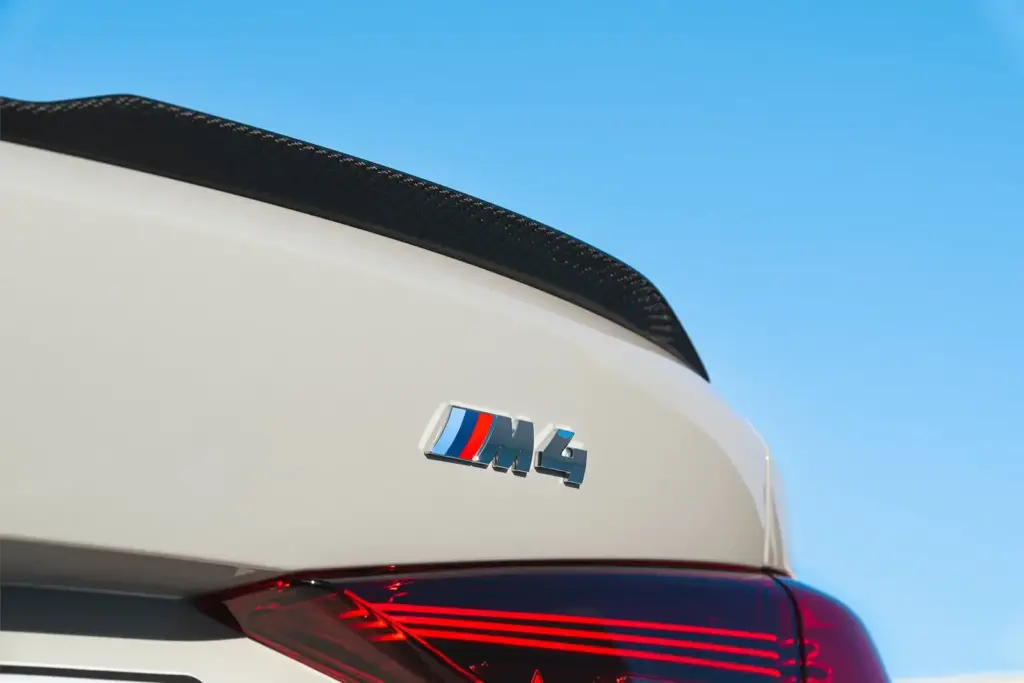
Exterior Design and Style
2025 Styling Updates
BMW’s mid-cycle refresh brings meaningful exterior refinements while maintaining the M4’s aggressive character[2].
New for 2025:
- Revised LED headlights: Narrower profile with updated LED daytime running light signature creating sharper appearance
- Laser LED taillights: Technology borrowed from limited-production M4 CSL, featuring 3D depth and distinctive nighttime signature
- Updated badges: New exterior badge styling with refined BMW roundel treatment
- Aerodynamic refinements: Subtle front fascia adjustments improving cooling and downforce
These changes keep the M4 visually fresh without requiring complete redesign, a strategic approach allowing BMW to invest development resources into powertrain and technology improvements.
Bold and Athletic Coupe Styling
The M4’s design polarizes opinion but undeniably commands attention. Dense, muscular bodywork creates an imposing road presence enhanced by functional aerodynamic elements.
Design highlights:
- Exaggerated front air intakes managing cooling for high-output engine
- Sculpted character lines flowing from front fenders to rear haunches
- Aggressive wheel arch flares accommodating wide stagger setup (19″/20″ front/rear)
- M-specific side mirrors with aerodynamic shaping
- Quad exhaust tips integrated into sculpted rear diffuser
The design emphasizes width and planted stance, with the M4 appearing to hunker down over its massive performance tires. Even stationary, the M4 conveys performance intent through proportions and details.
The Controversial Kidney Grille
The M4’s most polarizing element remains its oversized vertical kidney grille[1].
Grille characteristics:
- Size: Significantly larger than traditional BMW horizontal kidneys
- Orientation: Vertical design inspired by classic BMW models like the 328
- Reception: “Love-it-or-hate-it” reaction with little middle ground
- Functionality: Manages airflow for intercoolers and engine cooling
- 2025 update: Horizontal slat treatment provides slightly refined appearance
One reviewer described the M4 as having “a mug only a mother could love,” capturing the divisive nature of the design[1]. However, supporters appreciate the aggressive presence and historical references. Potential buyers should view the M4 in person, as photographs often exaggerate the grille’s visual impact.
Convertible Body Style (Competition xDrive Only)
The M4 Convertible exclusively comes in Competition xDrive specification, featuring a sophisticated power-operated soft top[2].
Convertible features:
| Specification | Details |
|---|---|
| Top operation | 18 seconds, functional up to 31 mph |
| Weight penalty | Approximately 300 pounds vs coupe |
| Trunk capacity | 7.5 cu ft with top down, 11 cu ft with top up |
| Starting price | $97,175 (vs $90,175 for Competition xDrive Coupe) |
The multi-layer fabric top provides excellent noise insulation when raised, though wind noise increases compared to the coupe’s fixed roof. The $7,000 premium and performance compromises make the convertible a niche choice for buyers prioritizing open-air driving over ultimate capability.
Carbon Fiber and Performance Elements
BMW incorporates carbon fiber strategically throughout the M4 to reduce weight while enhancing structural rigidity.
Standard carbon-fiber components:
- Roof panel (coupe models): Saves approximately 11 pounds while lowering center of gravity
- Roof brace: Increases chassis stiffness
Optional carbon-fiber components:
- Mirror caps ($650)
- Front splitter and side skirts ($1,200 combined)
- Rear spoiler ($1,500)
- Interior trim panels (part of packages)
The M4 CS takes carbon fiber usage further with extensive weight-saving components contributing to its 70-pound reduction versus standard Competition models[5].
Quad exhaust tips exit through a sculpted rear diffuser creating visual drama matched by acoustic intensity. The standard exhaust delivers satisfying sound, though some enthusiasts find it less characterful than previous naturally-aspirated M engines.
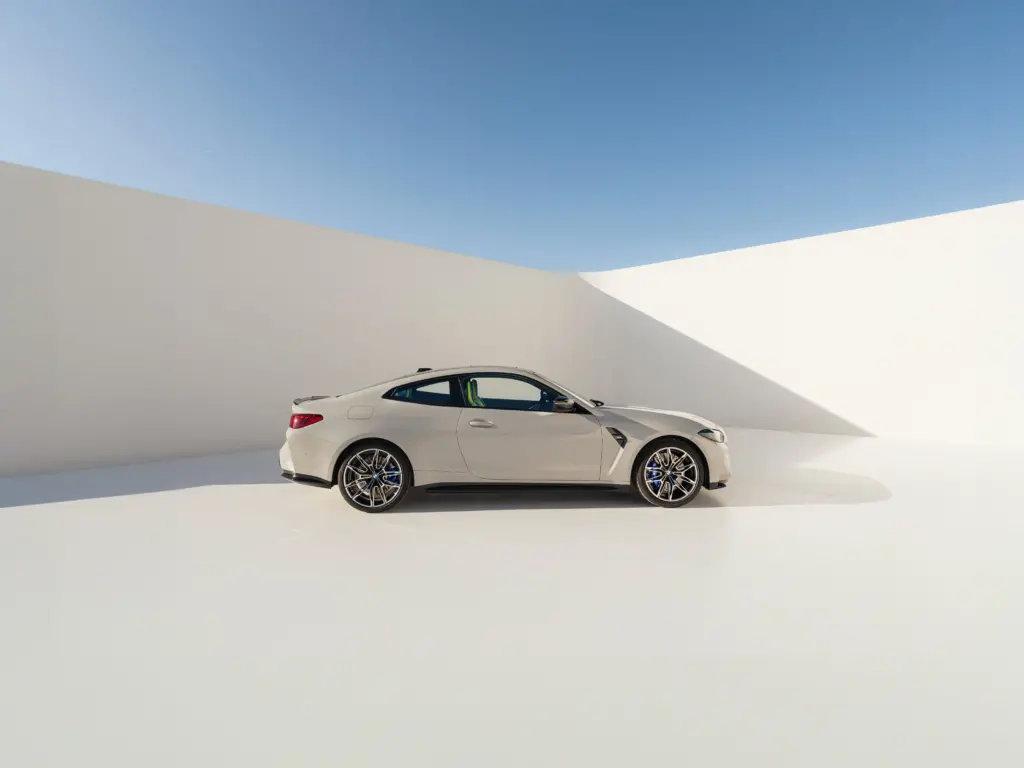
Available Exterior Colors
Standard Paint Options
BMW offers six no-cost and premium paint options for the 2025 M4[2].
| Color Name | Type | Additional Cost |
|---|---|---|
| Alpine White | Solid | No charge |
| Black Sapphire Metallic | Metallic | $550 |
| Portimao Blue Metallic | Metallic | $550 |
| Skyscraper Grey Metallic | Metallic | $550 |
| Isle of Man Green Metallic | Metallic | $550 |
| Dravit Grey Metallic | Metallic | $550 |
Metallic paints add subtle depth and premium appearance compared to solid Alpine White. Portimao Blue represents BMW M’s signature color, appearing frequently in marketing materials and offering excellent visibility.
BMW Individual and Exclusive Colors
BMW Individual extends the palette with exclusive options requiring extended lead times.
Individual paint options:
- Frozen finishes: Matte paint requiring specialized care ($5,000 premium)
- Cape York Green Metallic: Exclusive green with metallic flake ($2,500)
- Vegas Red Metallic: Vibrant red standing out in traffic ($2,500)
- Custom color matching: Any color possible with 12-16 week lead time ($8,000+)
M4 CS exclusive colors:
- Frozen Tanzanite Blue Metallic (CS and limited VR46 Edition)
- Marina Bay Blue Metallic (CS models)
- CS-specific graphics packages in High Gloss Black or Red
Buyers pursuing Individual colors should discuss options early in the purchase process to accommodate extended production timelines.
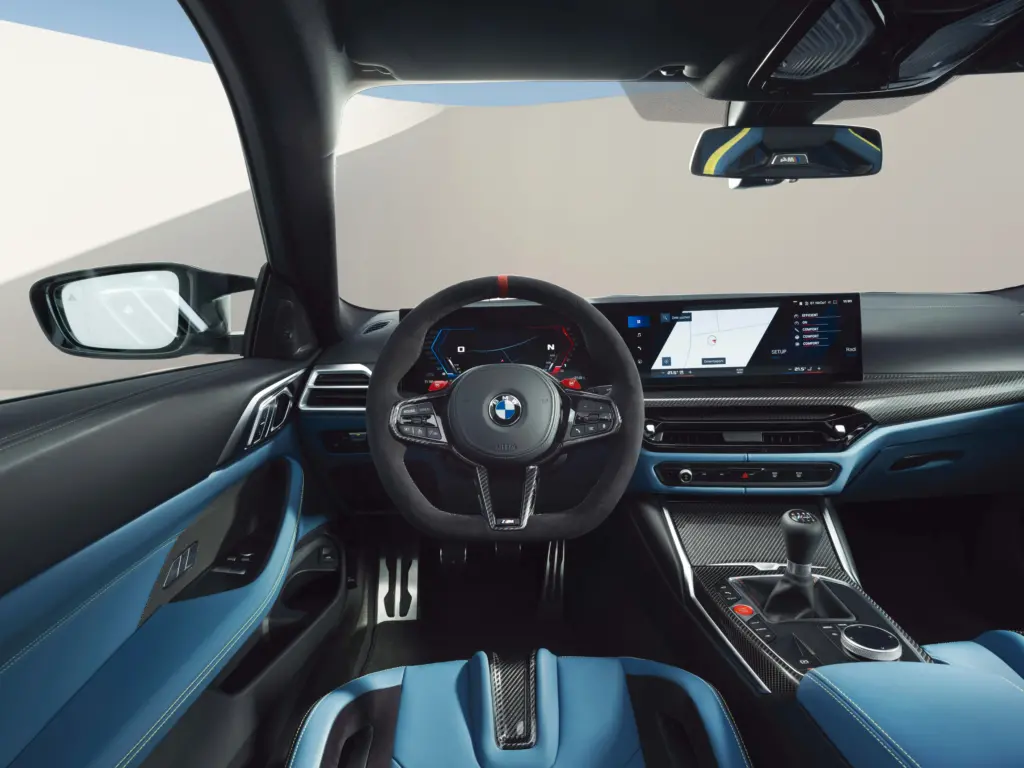
Interior and Cabin Quality
Seating and Premium Materials
The M4 cabin balances performance focus with luxury appointments, starting with excellent standard seating[2].
Seating options:
| Seat Type | Features | Cost | Notes |
|---|---|---|---|
| M Sport seats | Enhanced bolstering, Merino leather, integrated headrests | Standard | Excellent balance of support and comfort |
| Ventilated seats | Cooling airflow for summer | $500 | Popular in southern climates |
| M carbon bucket seats | Ultra-bolstering, 21-pound weight savings | $4,000 | Tight fit, difficult entry/exit |
Reviewers consistently praise standard M Sport seats for providing all-day comfort while delivering sufficient lateral support for aggressive driving. The carbon bucket seats serve dedicated track enthusiasts but compromise daily usability.
Some owners note “too much front seat bolstering” can feel restrictive for larger occupants, though most find the contouring appropriate for the M4’s performance mission.
Interior Color Combinations
BMW offers eight interior color schemes allowing personalization beyond typical black leather[2].
Available combinations:
- Black: Classic performance aesthetic with contrast stitching options
- Yas Marina Blue/Black: Bold two-tone matching M signature exterior color
- Silverstone/Black: Subtle grey creating sophisticated ambiance
- Kyalami Orange/Black: Vibrant racing-inspired combination
- Ivory White: Light-colored leather requiring more maintenance
- Tartufo/Black: Rich brown providing warm, premium feel
- Fiona Red/Black: Dramatic red emphasizing sporting character
- M Gold Bronze accents: Available on select colors
Each combination includes matching door panel inserts, dashboard accents, and floor mats with M4 embroidery. Contrast stitching adds visual interest while highlighting the premium materials throughout the cabin.
Rear Seat Space and Practicality
Performance coupes sacrifice rear-seat practicality by design, and the M4 follows this pattern[2].
Rear seat specifications:
- Legroom: 33.1 inches (significantly compromised behind tall front passengers)
- Headroom: 35.4 inches
- Shoulder room: 52.8 inches
- Access: Requires folding front seats forward
The back seat accommodates children comfortably or adults for short trips. However, four-adult transport over extended distances proves uncomfortable. Access requires folding front seats forward and climbing over bolstered sides—a cumbersome process discouraging frequent rear-passenger use.
Buyers needing regular four-adult capability should strongly consider the 2025 BMW M3 sedan, which offers identical performance with vastly improved rear access and space.
Cargo and Trunk Space
The M4 Coupe provides modest but adequate cargo capacity for a performance coupe[2].
Cargo specifications:
| Body Style | Trunk Capacity | Notes |
|---|---|---|
| Coupe (standard) | 11-12 cubic feet | Adequate for weekend trips or track-day tires |
| M4 CS Coupe | 16 cubic feet | Increased capacity through weight reduction efforts |
| Convertible (top up) | 11 cubic feet | Standard capacity |
| Convertible (top down) | 7.5 cubic feet | Soft-top mechanism reduces usable space |
Split-folding rear seats expand capacity for long items like track-day equipment, though the opening’s height limits maximum cargo size. The trunk opening proves wide enough for golf bags or multiple soft suitcases, making weekend getaways feasible.
Interior Fit and Finish
BMW maintains excellent interior quality standards throughout the M4 range, justifying its premium pricing[2].
Quality highlights:
- Genuine Merino leather on seats, dashboard, and door panels
- Standard Dark Graphite matte interior trim creating sporty ambiance
- Optional Polished Aluminum cabin trim for modern aesthetic
- Ambient lighting integrated into central air vent surrounds
- Precise panel gaps and solid construction feel
- M-specific details including tri-color stitching and illuminated door sills
The iDrive 8.5 curved display integrates seamlessly into the dashboard architecture, though some enthusiasts lament the minimalist design’s departure from traditional button-rich BMW interiors. Overall fit and finish match or exceed German competitors while surpassing American alternatives.
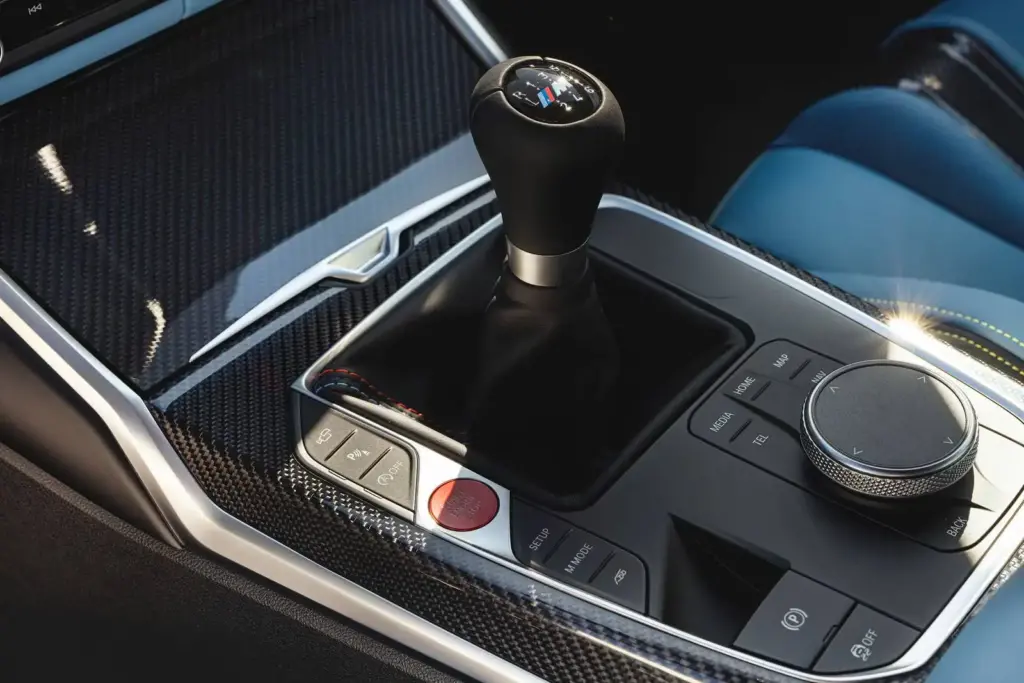
Technology and Infotainment
BMW Curved Display with iDrive 8.5
The 2025 M4 features BMW’s latest iDrive 8.5 interface combining digital instrumentation and infotainment under a unified curved glass display[2].
Display specifications:
- Digital instrument cluster: 12.3-inch configurable screen with multiple layout options
- Central touchscreen: 14.9-inch high-resolution display with haptic feedback
- Graphics quality: Crisp, responsive rendering with M-specific performance data
- Integration: Seamless curved glass creates premium appearance
M-specific displays include:
- G-force meter showing lateral and longitudinal acceleration
- Turbo boost pressure gauge monitoring engine performance
- Oil temperature and pressure readouts
- Lap timer with sector splits (when equipped with Track Package)
- Tire pressure and temperature monitoring
The interface allows extensive customization of home screen layouts, widget placement, and menu structures. However, the learning curve proves steep—multiple reviewers note the “large number of menus takes time to master”[2].
Control Methods and User Interface
BMW thoughtfully provides multiple control methods accommodating different user preferences.
Interface control options:
- Direct touchscreen: Responsive touch with haptic feedback confirming inputs
- iDrive rotary controller: Maintained from previous generation for tactile control
- Voice commands: “Hey BMW” activates BMW Intelligent Personal Assistant
- Steering wheel controls: Dedicated buttons and scroll wheels
- Gesture controls: Optional hand-motion recognition (part of Executive Package)
The variety prevents forcing users into touchscreen-only interaction, though the system’s complexity means most owners utilize only a fraction of available features. Setting up favorites and home screen shortcuts streamlines access to frequently used functions.
Smartphone Integration
Wireless connectivity comes standard, eliminating cable clutter in the cabin[2].
Connectivity features:
- Wireless Apple CarPlay: Seamless iPhone integration for navigation, messaging, and media
- Wireless Android Auto: Full-featured Android phone integration
- Wireless charging pad: Located in center console (sometimes causes phones to slide during spirited driving)
- Bluetooth audio: High-quality wireless streaming
- USB-C ports: Wired charging and data transfer
The Wi-Fi hotspot requires separate AT&T subscription starting at $20 monthly. Most buyers simply use phone tethering rather than paying additional monthly fees.
Audio and Entertainment Systems
The 16-speaker Harman Kardon surround sound system comes standard—a feature often optional on lower BMW models[2].
Audio systems:
| System | Speakers | Power | Cost | Notes |
|---|---|---|---|---|
| Harman Kardon | 16 speakers | 464 watts | Standard | Excellent quality for performance car |
| Bowers & Wilkins Diamond | 18 speakers | 655 watts | $4,200 | Premium upgrade with diamond tweeters |
The standard Harman Kardon system satisfies most buyers, delivering clear vocals, tight bass, and impressive soundstage. Audiophiles appreciate the Bowers & Wilkins upgrade, though the $4,200 premium represents significant cost relative to sonic improvements.
Navigation and Connected Services
Built-in navigation with real-time traffic comes standard, utilizing GPS and cellular connectivity for route optimization[2].
Navigation features:
- Predictive routing learning common destinations
- Real-time traffic integration with automatic rerouting
- Speed limit information with visual and audio alerts
- Augmented reality directions (overlaying arrows on camera feed)
BMW ConnectedDrive services include:
- Remote lock/unlock via smartphone app
- Stolen vehicle tracking and recovery assistance
- Remote horn and lights activation for parking lot location
- Digital key functionality allowing phone-based vehicle access
- Remote climate pre-conditioning starting HVAC before entering
- Automatic collision notification alerting emergency services
Services require subscription after initial 3-year complimentary period ($200 annually for full suite). Over-the-air software updates allow BMW to add features and improvements post-purchase without dealer visits.
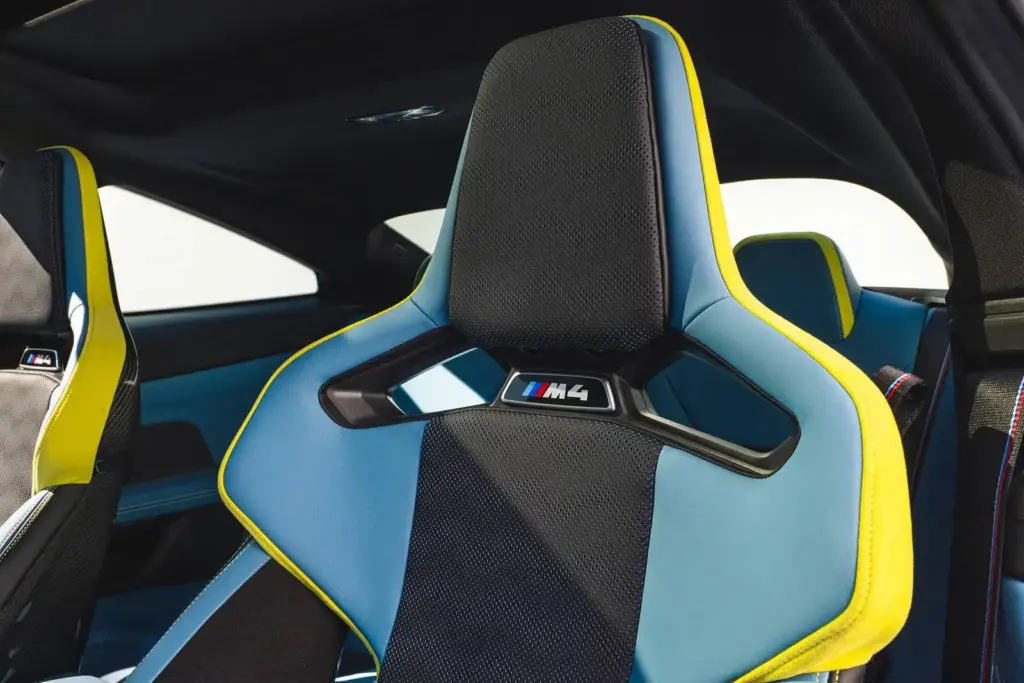
Safety and Driver Assistance
Standard Safety Features
BMW Active Driving Assistant comes standard on all 2025 M4 trims, providing comprehensive active safety technologies[2].
Standard safety systems:
- Automatic emergency braking: Detects pedestrians, cyclists, and vehicles, applying brakes if driver doesn’t respond
- Frontal collision warning: Audio and visual alerts with city braking function
- Blind-spot monitoring: Visual indicators in side mirrors when vehicles occupy blind zones
- Lane departure warning: Audio and steering wheel vibration alerts when drifting
- Lane-keeping assist: Gentle steering corrections maintaining lane position
- Rear cross-traffic alert: Detects approaching vehicles when reversing from parking
- Automatic high-beam assist: Manages high beams based on oncoming traffic
These systems function reliably in most conditions, though aggressive performance driving may trigger false warnings. Most systems can be temporarily disabled through iDrive menus for track use.
Advanced Driver Assistance Packages
The Driving Assistance Professional Package ($1,700) adds semi-autonomous capabilities for highway driving[2].
Professional Package features:
- Adaptive cruise control with stop-and-go: Maintains set following distance in all traffic conditions
- Extended traffic jam assistant: Provides steering and speed control up to 37 mph in congestion
- Steering and lane control assist: Active lane centering on highways reducing driver workload
- Evasion aid: Assists steering around sudden obstacles while maintaining stability
While not full autonomous driving, these features significantly reduce fatigue during long highway drives. The system requires hands on steering wheel every 15-20 seconds, preventing true hands-free operation but allowing relaxed cruising.
Parking and Visibility Technology
Standard front and rear parking sensors provide audio distance warnings when maneuvering in tight spaces. The Parking Assistant Package ($700) enhances capability[2].
Parking technologies:
- 3D Surround View: 360-degree overhead camera view with multiple perspective options
- Parking Assistant Plus: Automated parallel and perpendicular parking
- Reversing Assistant: Records last 50 feet of forward travel, automatically reversing along same path
- Backup camera: Standard with dynamic guidelines
The M4’s wide body and limited rear visibility make these features worthwhile investments, particularly for urban parking situations. The automated parking system works reliably in clearly marked spaces, though many drivers prefer manual control.
Airbags and Crash Protection
The M4 includes eight airbags strategically positioned for occupant protection[2].
Safety features:
- Dual front airbags with multi-stage deployment adapting to crash severity
- Front side-impact airbags integrated into seat structures
- Head-protection side-curtain airbags for front and rear occupants
- Knee airbags for driver and front passenger protecting lower extremities
Advanced body structure incorporates high-strength steel and aluminum creating a rigid safety cell surrounding occupants while managing crash energy through engineered deformation zones. Performance engineering doesn’t compromise occupant safety—the structure balances stiffness for handling with appropriate crush characteristics.
Crash Test Ratings and Reliability
Neither NHTSA nor IIHS has published crash test ratings for the 2025 BMW M4 as of October 2025. Low-volume performance vehicles often don’t undergo full crash testing protocols due to limited production numbers and high testing costs[7].
Reliability considerations:
Consumer Reports assigns the 4 Series platform average predicted reliability. RepairPal data for M4 models remains limited due to low production volumes, though BMW’s brand-wide reliability rating of 2.5 out of 5.0 ranks 30th among 32 manufacturers.
Common M4 issues reported by owners include:
- PCV valve failures causing rough idle and check engine lights (addressed in newer S58 engines)
- Turbocharger wastegate rattle at specific RPM ranges
- Electronic glitches requiring software updates
- Transmission issues in some early production models[7]
One Reddit user documenting a used 2025 M4 with 13,000 miles noted eight service visits in five months, raising concerns about reliability[7]. However, BMW’s 4-year/50,000-mile comprehensive warranty and included maintenance help offset repair costs during initial ownership.
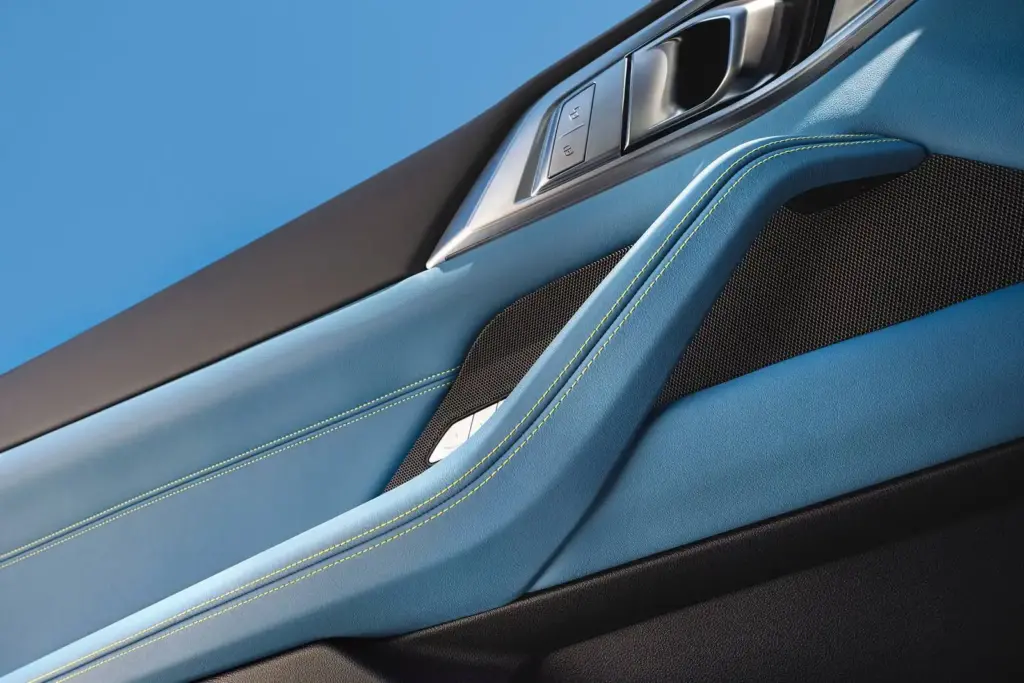
Fuel Economy and Real-World MPG
EPA Fuel Economy Ratings
Official EPA ratings vary minimally across M4 configurations despite power differences[1].
| Trim | City MPG | Highway MPG | Combined MPG |
|---|---|---|---|
| Base Manual | 16 | 23 | 19 |
| Competition RWD | 16 | 23 | 19 |
| Competition xDrive | 16 | 22 | 18-19 |
| M4 CS | 16 | 22 | 18 |
The all-wheel-drive system adds minimal efficiency penalty despite additional mechanical complexity. City ratings remain consistent at 16 mpg across the lineup, as stop-and-go driving taxes any high-performance engine.
Real-World Fuel Economy Testing
Car and Driver’s 75-mph highway fuel economy test achieved an impressive 28-29 mpg—significantly better than EPA highway estimates[1]. This demonstrates excellent efficiency when cruising at steady speeds with moderate throttle application.
Owner-reported fuel economy:
- Highway cruising: 26-29 mpg possible at 65-75 mph
- Mixed driving: 17-21 mpg typical for daily commuting
- Aggressive driving: 12-14 mpg during spirited runs or track days
- Pure track use: 8-10 mpg under sustained high-load conditions
Driving style dramatically impacts efficiency. Disciplined highway driving regularly achieves 26-28 mpg, while taking advantage of the M4’s performance drops consumption into the low teens. The wide range reflects the engine’s flexibility across use cases.
Fuel Requirements and Operating Costs
Premium unleaded gasoline (91+ octane) is mandatory for optimal performance and engine protection[1].
Fuel specifications:
- Tank capacity: 15.6 gallons
- Premium fuel requirement: 91+ octane mandatory (93 octane recommended)
- Highway range: Approximately 360 miles (23 mpg × 15.6 gallons)
- Combined range: Approximately 296 miles (19 mpg × 15.6 gallons)
Annual fuel cost estimates:
Assuming 12,000 miles annually and current national average premium fuel prices ($4.10/gallon as of October 2025):
- Conservative driving (20 mpg avg): $2,460/year
- Mixed driving (18 mpg avg): $2,733/year
- Aggressive driving (15 mpg avg): $3,280/year
Using regular gasoline triggers knock sensors reducing power output and fuel economy while potentially causing long-term engine damage. Always use premium fuel as specified in the owner’s manual.
For comparison, the Mercedes-AMG C63 hybrid returns approximately 14 city/22 highway, while the Audi RS5 achieves 17 city/26 highway. The M4’s efficiency proves competitive within the high-performance coupe segment.
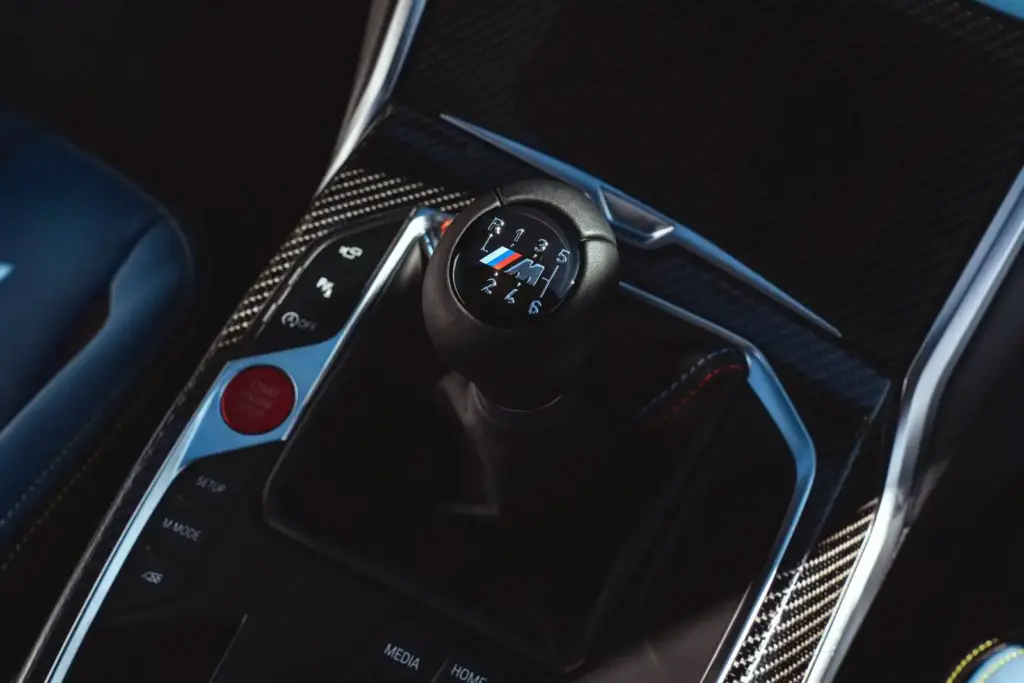
Warranty and Maintenance
Factory Warranty Coverage
BMW provides competitive coverage exceeding some German rivals[1].
| Coverage Type | Duration/Mileage |
|---|---|
| Limited warranty | 4 years / 50,000 miles |
| Powertrain warranty | 4 years / 50,000 miles |
| Corrosion perforation | 12 years / unlimited miles |
| Roadside assistance | 4 years / unlimited miles |
This warranty structure surpasses Mercedes-AMG and matches Audi’s comprehensive coverage. The unified 4-year duration for both limited and powertrain coverage eliminates confusion about component classification.
Complimentary Scheduled Maintenance
BMW includes scheduled maintenance at no cost for 3 years or 36,000 miles—whichever occurs first[1].
Covered maintenance includes:
- Oil and filter changes (annually or per vehicle recommendation)
- Brake fluid replacement at specified intervals
- Multi-point vehicle inspections documenting condition
- Software updates addressing bugs or adding features
- Cabin air filter replacement
- Wiper blade replacement
This represents approximately $2,100-$2,800 value based on typical BMW dealership labor rates. Mercedes-AMG and Audi charge for scheduled maintenance from day one, making BMW’s inclusion a significant competitive advantage.
Maintenance must be performed at authorized BMW dealerships to maintain coverage, though some independent specialists offer BMW-approved service. Service intervals typically occur annually for moderate-mileage drivers averaging 10,000-12,000 miles per year.
Extended Warranty and CPO Options
BMW Ultimate Care+ extends comprehensive and maintenance coverage beyond factory terms.
Extended warranty options:
- Ultimate Care+ 5/60: Extends to 5 years/60,000 miles ($2,400-$3,200)
- Ultimate Care+ 6/100: Extends to 6 years/100,000 miles ($4,200-$5,800)
- Ultimate Care+ 8/125: Maximum extension to 8 years/125,000 miles ($6,500-$8,500)
Certified Pre-Owned warranty:
Used M4s purchased through BMW’s CPO program receive extended warranty coverage to 6 years/100,000 miles from original in-service date, plus roadside assistance and trip-interruption coverage.
Extended warranty value depends on ownership duration and annual mileage. Buyers planning 3-4 year ownership cycles typically skip extended coverage, while long-term owners benefit from protection against expensive repairs. For buyers evaluating acceptable mileage on used performance cars, M4s with documented maintenance history remain viable through 60,000-70,000 miles.
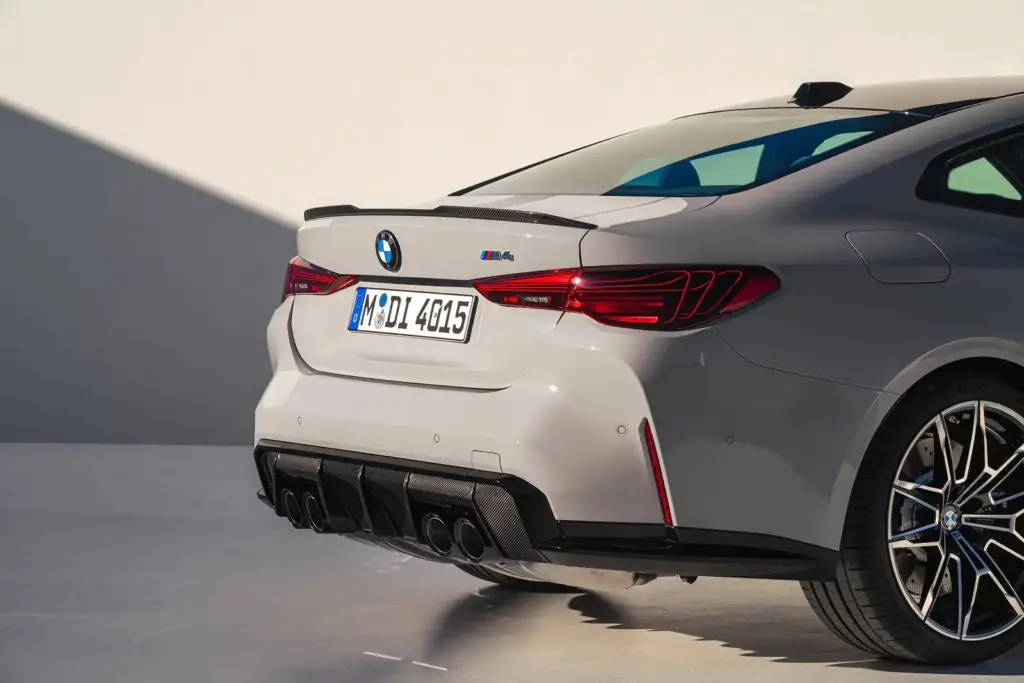
Used 2025 BMW M4 Market
Depreciation and Resale Value
Luxury performance vehicles experience aggressive depreciation, and the M4 follows typical patterns for this segment[8].
| Time Period | Retained Value | Depreciation | Estimated Resale Value* |
|---|---|---|---|
| 1 Year | 70-73% | 27-30% | $77,000-$80,500 |
| 2 Years | 65-70% | 30-35% | $71,500-$77,000 |
| 3 Years | 60% | 40% | $66,000 |
| 5 Years | 46% | 54% | $50,600 |
*Based on $110,000 purchase price (average with options)
The M4 loses approximately $20,000-$30,000 in the first year—typical for luxury performance cars facing immediate market correction from dealer markup and initial enthusiasm[8]. Depreciation stabilizes somewhat in years 2-5 as vehicles enter enthusiast ownership rather than new-car-buyer churn.
Best Time to Buy Used
The depreciation curve suggests optimal value purchasing 2-3 year-old M4s, saving approximately $32,000-$44,000 versus new while obtaining relatively low-mileage examples[8].
Certified Pre-Owned advantages:
- Extended BMW warranty to 6 years/100,000 miles from original in-service date
- 360-point inspection ensuring vehicle condition
- Roadside assistance and trip interruption coverage
- Access to BMW Financial Services competitive rates
CPO M4s typically command $2,000-$4,000 premium over private-party examples, though warranty coverage and peace of mind often justify the difference. Buyers should avoid first-year 2021 models (G82 chassis introduction) due to early production issues. Model years 2022-2025 incorporate refinements addressing initial concerns.
What to Inspect on Used M4s
Pre-purchase inspection priorities:
- Service history documentation: Verify all scheduled maintenance performed at BMW dealerships or qualified independents
- Track use indicators: Inspect brake pad/rotor thickness, tire wear patterns, undercarriage damage from curbing
- PCV valve replacement: Confirm completion on 2021-2022 models experiencing rough idle
- S58 engine condition: Compression testing and leak-down test for higher-mileage examples
- Tire condition and age: Performance tires require replacement every 15,000-25,000 miles
- Paint thickness measurement: Identifies body work from unreported collisions
- Accident history: Obtain Carfax/AutoCheck reports verifying clean title
The Reddit user’s experience with eight service visits in five months highlights importance of thorough pre-purchase inspection[7]. Always obtain independent inspection from qualified BMW specialist before purchasing any used M4.
Used Pricing Trends and Market Availability
Current used M4 market (October 2025):
| Model Year | Mileage Range | Price Range |
|---|---|---|
| 2025 models | 3,000-10,000 miles | $78,000-$88,000 |
| 2024 models | 8,000-18,000 miles | $74,000-$84,000 |
| 2023 models | 15,000-25,000 miles | $68,000-$78,000 |
| 2022 models | 20,000-35,000 miles | $64,000-$74,000 |
| 2021 models | 30,000-45,000 miles | $58,000-$68,000 |
Competition models command $4,000-$8,000 premium over base configurations. Manual transmission examples occasionally fetch slight premiums in enthusiast markets, though automatic models sell more quickly due to broader appeal. Geographic location significantly affects pricing—M4s command premiums in coastal markets versus Midwest availability.
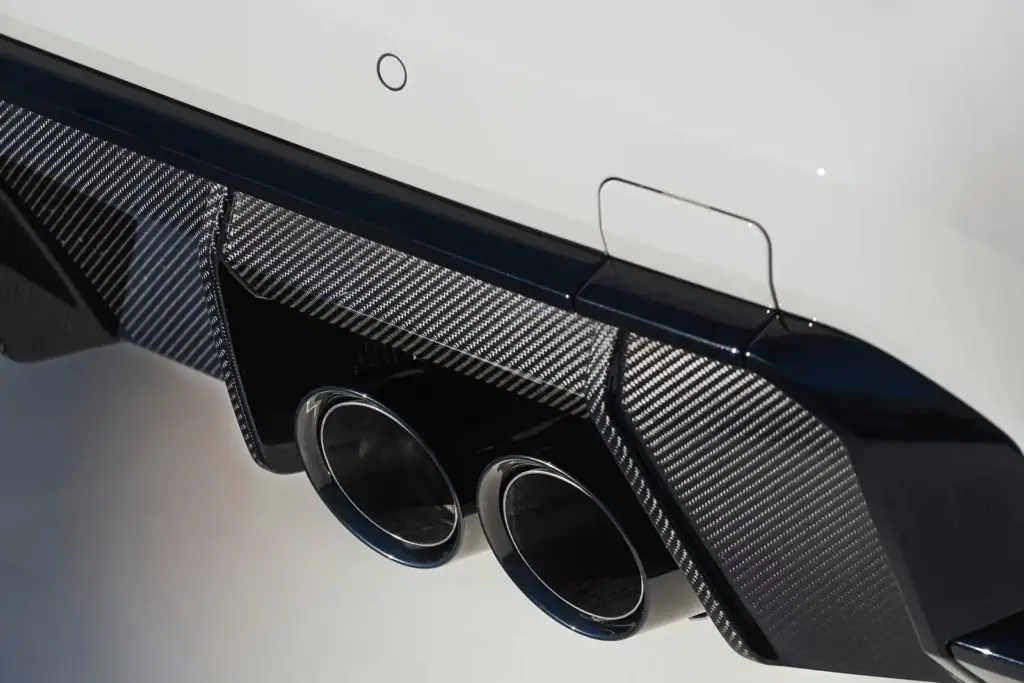
Competitive Comparison and Alternatives
2025 BMW M4 vs Mercedes-AMG C63
The Mercedes-AMG C63 underwent radical transformation for 2024, adopting plug-in hybrid technology dramatically changing its character.
Comparison:
| Specification | BMW M4 Competition xDrive | Mercedes-AMG C63 S E Performance |
|---|---|---|
| Engine | 3.0L twin-turbo I-6 | 2.0L turbo I-4 + electric motor |
| Total power | 523 hp | 671 hp |
| Torque | 479 lb-ft | 752 lb-ft |
| Weight | 3,990 lbs (1,810 kg) | 4,649 lbs (2,109 kg) |
| 0-60 mph | 3.4 seconds | 3.3 seconds |
| Starting MSRP | $90,175 | ~$84,000 |
The new C63 delivers massive power but adds significant weight through its hybrid system. The M4 maintains traditional performance-car dynamics with lower mass and simpler drivetrain. Sound enthusiasts prefer the M4’s inline-six character over the C63’s muted four-cylinder/hybrid exhaust note.
Mercedes counters with superior interior materials and more advanced autonomous driving features. Buyers prioritizing raw driving engagement typically favor the M4, while luxury-focused buyers lean toward Mercedes refinement.
2025 BMW M4 vs Audi RS5
The Audi RS5 Sportback delivers 444 horsepower from a 2.9L twin-turbo V6 through standard Quattro all-wheel drive.
Key differences:
M4 advantages:
- 79 additional horsepower (523 hp vs 444 hp)
- Rear-wheel-drive option for purist dynamics
- Manual transmission availability (base model)
- Lighter curb weight by approximately 200 pounds
- More aggressive styling and presence
RS5 advantages:
- Sportback body style offering rear hatchback practicality
- More conservative exterior design aging gracefully
- Virtual Cockpit digital display praised for user interface
- Better fuel economy (17 city/26 highway/20 combined)
- Standard Quattro AWD provides excellent traction
Pricing proves similar with RS5 Sportback starting at $77,200. The RS5 suits buyers prioritizing daily usability and subtle performance, while the M4 serves track enthusiasts wanting maximum capability and dramatic styling.
2025 BMW M4 vs Cadillac CT4-V Blackwing
The Cadillac CT4-V Blackwing represents American high-performance at $62,990—$17,105 less than the base M4.
Value proposition comparison:
- Performance: Blackwing’s supercharged 3.6L V6 produces 472 hp (nearly matching base M4)
- Transmission: Manual standard, automatic optional (same as M4)
- Handling: Magnetic ride control provides excellent balance
- Interior: Spacious sedan practicality with comfortable rear seats
- Technology: Cadillac’s interface lags BMW’s iDrive 8.5 sophistication
- Build quality: Good but not matching German standards
- Resale value: Significantly weaker than BMW
The Blackwing appeals to value-conscious enthusiasts willing to sacrifice brand prestige for performance-per-dollar. It delivers 90% of M4’s capability at 79% of the price, though interior materials and technology can’t match German standards.
2025 BMW M4 vs Alfa Romeo Giulia Quadrifoglio
The Alfa Romeo Giulia Quadrifoglio offers Italian character at $82,990—similar pricing to the base M4.
Comparison highlights:
Alfa Romeo advantages:
- 505 hp twin-turbo V6 with characterful engine note
- More engaging steering feel with superior feedback
- Lighter weight providing nimble handling
- Distinctive Italian styling standing out from German rivals
- More analog driving experience
M4 advantages:
- More powerful Competition variants (523 hp)
- Superior build quality and interior materials
- Better reliability reputation and warranty coverage
- More advanced technology and driver assistance
- Stronger dealer network and parts availability
The Giulia Quadrifoglio appeals to enthusiasts prioritizing driving engagement and Italian flair over ultimate refinement. However, reliability concerns and limited dealer networks make the M4 a safer long-term ownership proposition.
2025 BMW M4 vs Porsche 911
The Porsche 911 Carrera starts at $116,000—significantly higher than the M4’s $80,875 base price.
Performance comparison:
- 911 Carrera: 379 hp from 3.0L twin-turbo flat-six, 0-60 mph in 3.9 seconds
- 911 Carrera S: 443 hp, 0-60 mph in 3.3 seconds
- M4 Competition xDrive: 523 hp, 0-60 mph in 3.4 seconds
911 advantages:
- Legendary Porsche handling precision and balance
- Superior build quality and materials throughout
- Stronger resale value retention (60-65% after 5 years)
- More engaging driving experience at all speeds
- Iconic design and brand cachet
M4 advantages:
- $30,000-$50,000 lower acquisition cost depending on 911 configuration
- More powerful standard engines (473-543 hp vs 379-443 hp)
- More practical rear seats and cargo space
- Better fuel economy (19 combined vs 17-18 combined)
- Included complimentary maintenance
The 911 represents the segment’s gold standard, though its premium pricing positions it as an aspirational upgrade rather than direct alternative. The M4 offers compelling performance at a more accessible price point, making it the “value” option in this comparison.
BMW M3 vs M4: Which to Choose
The BMW M3 sedan and M4 coupe share identical powertrains, chassis, and pricing—differing only in body style[1].
Comparison:
| Factor | M3 Advantage | M4 Advantage |
|---|---|---|
| Practicality | Four doors, easier rear access | Two-door coupe styling |
| Weight | 3,990 lbs | 3,935 lbs (55 lbs lighter) |
| Rear seat usability | Adults fit comfortably | Children/emergency only |
| Styling | Subtle performance sedan | Aggressive coupe presence |
| Resale value | Slightly stronger demand | Niche market |
| Daily driving | More practical year-round | Better for enthusiasts |
Performance differences prove negligible—both deliver virtually identical acceleration, handling, and braking. The decision centers entirely on lifestyle needs. Buyers needing regular rear-seat transport should choose the M3 without question. The M4 serves childless enthusiasts or families with separate practical vehicles.
For buyers comparing BMW performance models across the lineup, understanding BMW X3 M versus SUV alternatives helps clarify positioning across segments.
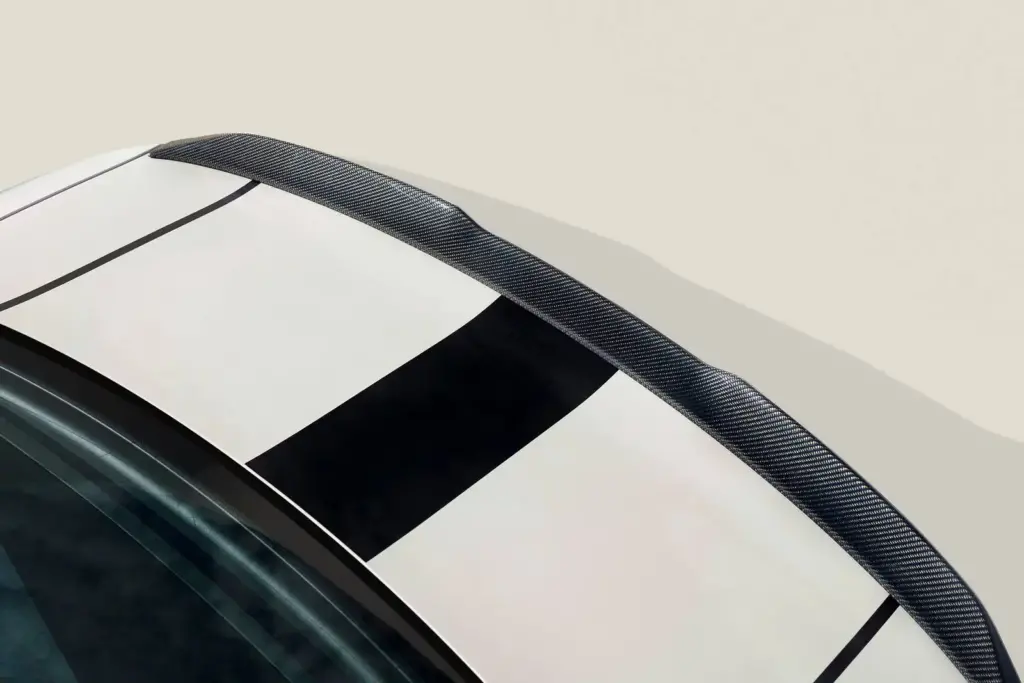
Is the 2025 BMW M4 Worth It?
Best Use Cases for the M4
The M4 excels in specific scenarios where its strengths align with buyer priorities.
Ideal ownership profiles:
- Track-day enthusiast with daily driver needs: The M4 handles repeated track sessions without overheating while remaining tolerable for commuting
- Performance buyer prioritizing speed over engagement: Those valuing straight-line acceleration and technology accept electronic character
- BMW loyalist wanting latest M technology: Brand enthusiasts appreciate iDrive 8.5, wireless connectivity, and M-specific features
- Manual transmission purist: Base model offers one of last available six-speed performance coupes
- Exclusivity seeker: M4 CS limited production (1,700 units) provides collector appeal
The M4 particularly suits buyers owning additional vehicles for family duties, allowing the coupe to serve purely as weekend driver and track car. Single-car households requiring rear-seat practicality should strongly consider the M3 sedan instead.
Who Should Skip the M4
Certain buyer profiles will find the M4’s compromises unacceptable.
Buyers who should look elsewhere:
- Comfort-first luxury buyers: Stiff suspension creates harsh ride quality unsuitable for those prioritizing isolation[1]
- Pure driving enthusiasts wanting analog feel: Numb steering and electronic character disappoint those seeking unfiltered connection
- Budget-conscious buyers: $80,875+ entry price plus premium fuel and insurance create significant ownership costs
- Those disliking controversial grille: The polarizing design won’t grow on skeptics over time
- Buyers needing practical rear seats regularly: Cramped quarters and difficult access frustrate family use
For buyers requiring better ride quality while maintaining performance, the 2025 BMW 540i delivers 70% of the M4’s capability with vastly improved comfort. The Audi RS5 Sportback provides similar performance with hatchback practicality.
Value Analysis: Which Trim to Choose
Selecting the optimal M4 trim depends on priorities and budget.
Trim recommendations by buyer profile:
| Buyer Type | Recommended Trim | Reasoning |
|---|---|---|
| Manual enthusiast | Base M4 | Last-generation stick shift, purist appeal, $80,875 entry |
| Track-day regular | Competition RWD | Rear-drive dynamics, 503 hp, no AWD complexity, $86,000 |
| All-weather performance | Competition xDrive | Maximum traction, 523 hp, snow capability, $90,175 |
| Collector/investor | M4 CS | Limited production, ultimate performance, exclusivity, $124,675 |
According to Autvex market analysis, Competition xDrive offers the best balance of performance, capability, and year-round usability for most buyers. The $10,000 premium over base manual nets 50 additional horsepower, all-wheel drive, and the superior automatic transmission.
The M4 CS serves collectors and track-focused buyers willing to pay $44,500 premium for exclusivity and ultimate capability. However, most enthusiasts find diminishing returns at that price point.
M4 Strengths vs Weaknesses Summary
Core strengths:
- Brutal twin-turbo power delivering exhilarating acceleration across all trims
- Advanced technology including iDrive 8.5, wireless connectivity, and M-specific performance displays
- All-weather capability through xDrive AWD maintaining rear-biased character
- Luxury interior with premium materials and excellent build quality
- Comprehensive warranty including complimentary 3-year maintenance
Notable weaknesses:
- Numb steering lacking tactile feedback compared to rivals and previous generations[1][3]
- Harsh ride quality transmitting road imperfections, especially with optional larger wheels
- Complex drive modes and settings creating steep learning curve
- Less engaging character than analog predecessors or current rivals
- Polarizing oversized kidney grille design
In the competitive landscape for 2025, the M4 positions itself as a high-tech GT car rather than pure sports coupe. Buyers prioritizing comfort, refinement, and technology over raw engagement will appreciate this evolution. Purists seeking unfiltered driving experiences may prefer alternatives like the Cadillac CT4-V Blackwing or Alfa Romeo Giulia Quadrifoglio.
Final Verdict and Recommendation
The 2025 BMW M4 earns its Editors’ Choice designation through well-rounded capability spanning daily driving, highway cruising, and track-day performance[1].
Final assessment:
Car and Driver praises the M4 for delivering “staggering acceleration, impressive handling, and a luxurious cabin,” noting it serves better as a GT car than pure sports car[1]. This characterization proves accurate—the M4 excels at covering ground quickly in comfort while retaining track capability when desired.
The 20-horsepower bump for Competition xDrive models represents meaningful improvement, making 2025 an ideal model year for buyers seeking maximum performance. Updated styling keeps the M4 visually fresh through the remainder of its generation cycle.
Autvex recommends the M4 for:
- Buyers seeking maximum performance with luxury appointments
- Track enthusiasts who drive their car to/from events
- Technology-focused buyers appreciating latest BMW innovations
- Previous M car owners upgrading to current generation
Consider alternatives if:
- Ride comfort ranks as top priority (consider BMW M340i or 540i instead)
- Pure driving engagement matters most (Cadillac CT4-V Blackwing, Alfa Giulia Quadrifoglio)
- Budget constraints limit spending (wait for used models depreciating 30-40%)
- Family practicality is essential (choose M3 sedan for identical performance)
Whether the M4 is “worth the hype” depends entirely on individual priorities. For buyers valuing straight-line speed, advanced technology, and luxury refinement, the M4 delivers compelling package despite steering feedback shortcomings. Traditional enthusiasts seeking visceral, analog driving experiences should test-drive carefully before committing, as the M4’s electronic character may disappoint.
For most buyers in the market for a high-performance luxury coupe priced around $90,000, the 2025 BMW M4 Competition xDrive represents the sweet spot—delivering 523 horsepower, all-wheel-drive traction, and comprehensive technology in a well-executed package that balances capability across diverse use cases.
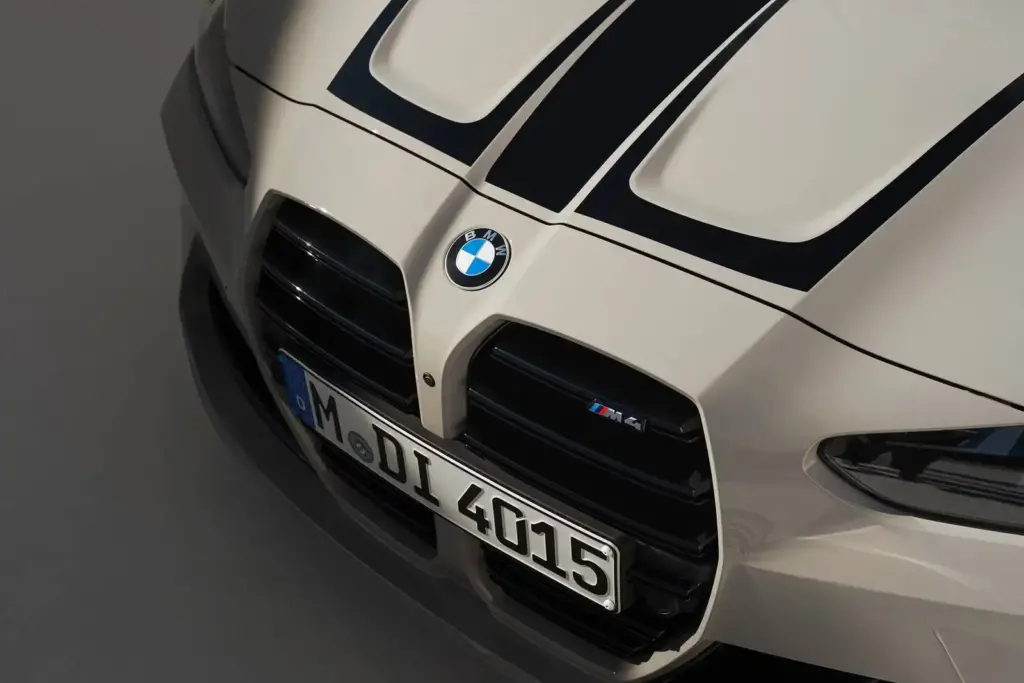
Key Takeaways
- The 2025 M4 Competition xDrive gains 20 horsepower to 523 hp, making it the quickest non-CS variant with 0-60 mph in 3.4 seconds[1].
- Revised LED headlights and laser taillights borrowed from M4 CSL plus updated iDrive 8.5 software keep technology current through 2025[2].
- Base manual M4 starting at $80,875 offers one of last available six-speed transmissions in luxury performance segment[4].
- Numb steering feel and sometimes harsh ride quality represent consistent criticisms across reviews, disappointing driving engagement purists[1][3].
- The M4 depreciates 54% over five years; buying 2-3 year old models saves $32,000-$44,000 versus new[8].
- BMW’s 4-year/50,000-mile warranty plus 3-year/36,000-mile complimentary maintenance exceeds Mercedes-AMG and Audi coverage[1].
- M4 CS at $124,675 delivers 543 hp and limited production exclusivity but costs $44,500 more than base model[5].
FAQs
How much does the 2025 BMW M4 cost?
What’s new on the 2025 BMW M4?
Is the BMW M4 Competition worth the extra money?
The Competition trim’s $6,000 premium delivers 30 additional horsepower (503 hp vs 473 hp), an eight-speed automatic transmission with launch control, and Competition-specific suspension tuning. However, it eliminates manual transmission availability. The upgrade proves worthwhile for buyers prioritizing maximum performance over engagement[1].
Can you get a manual transmission in the 2025 M4?
Yes, the six-speed manual transmission comes standard on the base M4 Coupe with rear-wheel drive and 473 horsepower. Competition models exclusively offer the eight-speed automatic. The manual represents one of the last available in the luxury performance segment[1].
What is the 0-60 time for the 2025 BMW M4?
How reliable is the 2025 BMW M4?
BMW’s brand reliability ranks 30th of 32 manufacturers with a 2.5/5.0 RepairPal rating. Common M4 issues include PCV valve failures and turbocharger wastegate rattle. However, the 4-year/50,000-mile warranty plus 3-year complimentary maintenance help offset repair costs during initial ownership[7].
What is the real-world fuel economy of the 2025 M4?
The EPA rates the M4 at 16 city/22-23 highway/18-19 combined mpg. Real-world testing achieved 28-29 mpg during highway cruising, while mixed driving typically returns 17-21 mpg. Aggressive driving drops efficiency to 12-14 mpg. Premium fuel (91+ octane) is mandatory[1].
BMW M3 or M4: which is better for daily driving?
The M3 sedan proves significantly better for daily driving with four doors, easier rear access, and comfortable adult rear seating. Both share identical powertrains and performance. Choose the M4 only if you don’t need practical rear seats regularly, as the coupe’s cramped quarters frustrate family use[1].
Does the 2025 M4 come with all-wheel drive?
All-wheel drive is available exclusively on Competition trims as the xDrive system. The base M4 offers only rear-wheel drive. Competition xDrive models produce 523 hp (20 more than RWD Competition) and achieve 0-60 mph in 3.4 seconds[1].
What are the main competitors to the 2025 BMW M4?
Primary rivals include the Mercedes-AMG C63 (now hybrid with 671 hp), Audi RS5 (444 hp), Cadillac CT4-V Blackwing ($62,990), Alfa Romeo Giulia Quadrifoglio (Italian character), and Porsche 911 (at significantly higher price). The M3 sedan offers identical performance with better practicality[1].
Is the 2025 BMW M4 a good daily driver?
The M4 serves as a capable but compromised daily driver. Its stiff suspension transmits road imperfections harshly, cramped rear seats limit practicality, and premium fuel requirements increase operating costs. It works best for enthusiasts with shorter commutes on smooth roads or those owning additional practical vehicles[1].
How does the 2025 M4 compare to previous generations?
The 2025 M4 (G82 chassis) delivers more power, better technology, and superior track capability versus previous generations. However, it sacrifices some driving engagement through numb steering and electronic character. The F80 and especially E92 generations offered more visceral, analog experiences that enthusiasts miss[1][3].
References
- Car and Driver. (2024). 2025 BMW M4 Review, Pricing, and Specs. https://www.caranddriver.com/bmw/m4
- Edmunds. (2025). 2025 BMW M4 Prices, Reviews, and Pictures. https://www.edmunds.com/bmw/m4/2025/
- Evo. (2025). BMW M4 2025 review – a brash, bruising and brilliant sports car. https://www.evo.co.uk/bmw/m4
- BMW USA. (2025). BMW 4 Series Coupe M Models. https://www.bmwusa.com/vehicles/m-series/bmw-4-series-m-models/bmw-m4-coupe.html
- Machines with Souls. (2025). The 2025 BMW M4 CS is the best M car I’ve ever driven. https://machineswithsouls.com/2025-bmw-m4-cs-review/
- Car and Driver. (2024). 2025 BMW M4 CS: Progress Is a Fickle Thing. https://www.caranddriver.com/reviews/a60847180/2025-bmw-m4-cs-drive/
- Reddit. (2025). Used 2025 BMW M4 with 13k miles and 8 Service Reports. https://www.reddit.com/r/BMW/comments/1iurq9o/used_2025_bmw_m4_with_13k_miles_and_8_service/
- CarEdge. (2024). BMW M4 Depreciation. https://caredge.com/bmw/m4/depreciation

I am a senior automotive analyst at Autvex. Expert vehicle evaluations, in-depth reviews, and objective analysis helping readers make informed automotive decisions with years of industry experience.

